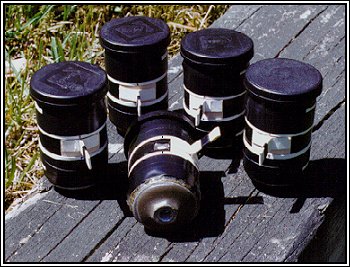

Pocket Pinhole cameras with tripod mounts
Advanced pinholers may want to try making cameras from black plastic 35mm film cans. As can be seen from the photo above, the cameras are scaled-down versions of the oatmeal-box pinhole camera. Three areas of difference are worth noting:
1) The pinhole is much smaller than that used in the oatmeal-box cameras. I use the same pinhole drill and #16 needle for the pocket pinholes, but I stop drilling when the tip of the needle can be seen protruding through the aluminum pinhole plate. I sand both sides carefully, then use the drill again with very little pressure, mostly to smooth the edges of the hole. Sand again, then rinse under the faucet and pat dry. Exposure times with these small cameras are about the same as for the larger oatmeal-box versions. Experiment a bit to find the optimum.
2) It is difficult to position these cameras, so I glue tripod mounts on their bottoms. Use a 7/16" nut with 1/4" inner diameter threads, glued to a flat washer 1 1/4" in diameter with a 1/4" hole. I use epoxy to glue the nut to the washer and the washer to the plastic camera body. Rough up the plastic to insure that the epoxy will stick to it. Any tripod can then be used to hold the cameras still and to precisely aim them. This can be done on the larger oatmeal-box cameras, too.
Another way to mount a pocket pinhole camera on a tripod is to glue a round magnet to the bottom of the filmcan camera and glue a 7/16" nut on a 1 1/4" flat washer. Attach the nut/washer to the tripod and then you can stick the camera to it: the magnet will hold the camera to the washer. This results in a useful "quick change" capability.
3) You will have to cut the film to fit the small camera. If "paper film" is used, the final prints will be contact size only, thus somewhat small. They will look like "Persian Miniatures." Sheet film can be used, especially if you have an enlarger. Enlargements of 5x7" can be made with good image definition. Sheet film must be handled in total darkness, which lets you practice "being blind", i.e., doing everything by feel alone. One benefit of using "pocket pinhole" cameras is that you can load a number of them and carry them in your pocket as you go around looking for interesting subjects to photograph. More often than not your subject will prove to be yourself, so what could be more interesting than that?
Check out www.pinhole.com for technical information on pinhole cameras, and for exhibits of photographs made with pinhole cameras.
Back - Home - Next